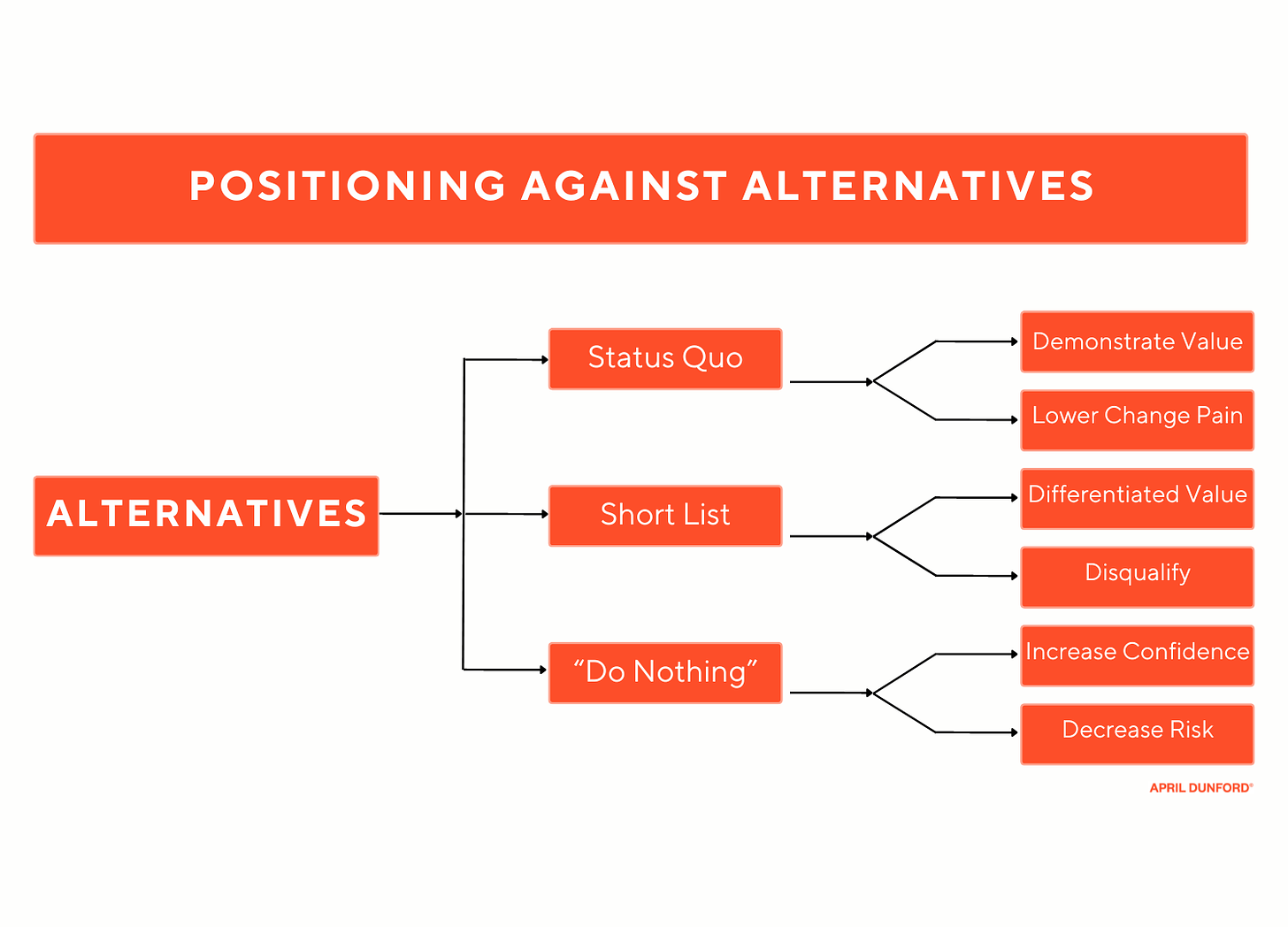In positioning work, we need to understand the competitive landscape or what we need to position against. In my opinion, many companies get this wrong because they get too caught up in their own definition of what “competition” means and forget that they need to look at it from a buyer’s perspective.
In B2B, customers always have alternative ways of getting a job done. They have three options:
-
Stick with what they already have – in general, the prospect is getting the job done today – it might be inefficient, expensive, and just plain awful – but it’s happening. The current situation might be painful, but so is switching to something new. It isn’t just a matter of finding the budget for the new thing. Processes might change, end users will need to be trained, and the new software might need to be integrated with existing systems and data. The more complex the solution is, the more painful it will be for customers to make the change.
-
Choose a new solution (you or one of a shortlist of selected competitors) – most B2B software is not purchased in a vacuum. B2B buyers do their homework and build a shortlist of solutions to evaluate. To win the deal, you will not only have to prove that your solution is valuable, but you will also have to prove that the solution provides MORE value than the others.
-
Do nothing – some folks mistake this option for number 1, but the research tells us that the majority of the time when a customer opts not to move forward with a deal, they are not explicitly casting a vote for the status quo. Instead, the prospect has not been able to confidently make a decision and instead chooses to abandon the purchase effort altogether. This indecision is fueled by the perceived risk of making a poor decision.
So to win a deal, we must successfully position against all three options. Let’s dig into how we do that.
How to position against the Status Quo
-
Demonstrate the value they cannot achieve today – The minimum bar we have to pass to get a prospect to consider doing something in a new way is to show them what they will get if they make the change. Very specifically, this is your differentiated value, i.e. ‘Companies that use our solution increase revenue by 30% on average over those that do the job manually.’ I call this the minimum bar because, for many companies, proving value won’t be enough to convince the company to make the change.
-
Reduce the pain of change – Helping customers move from the status quo can help reduce the work associated with a change. I’ve seen companies use migration tools and guides as one way to do this. Professional services to help a customer get started and onboarding assistance to ease the path for end users can also help. Sometimes, breaking the deal into smaller pieces or managing a slow but steady rollout of a new solution can also help smooth the pathway to adoption.
How to position against direct competitors
-
Demonstrate your differentiated value – Like positioning against the status quo, winning against more direct competition is all about showing what you can do for a customer’s business that the other considered alternatives cannot. Many companies fall into the trap of merely demonstrating how they can deliver value. Differentiated value is the reason why a customer chooses you over the other alternatives. It is essential to take a customer point of view in creating the list of direct competitors you have to position against – if a competitor rarely or never lands on a short list, that means your customers don’t seriously consider them, and they simply aren’t a competitor you have to position against. If and when they start to show up in deals, you can adjust your positioning to take them into account. Until then, you can ignore them – just like your prospects do.
-
Ruthlessly disqualify – It’s important to understand where you can deliver differentiated value and where you cannot. If the prospect doesn’t care about the value only you can deliver, you should disqualify them and move on to one that does. It sounds so simple, but most companies really struggle with this. In my opinion, the key is to ensure you have a really tight definition of your differentiated value. When you have that, it’s easier to answer the question – “What are the characteristics of a target account that make them care a lot about the value that only we can deliver?” If a prospect doesn’t check those boxes, you will waste time chasing a deal you are unlikely to win.
How to position against “do nothing”
Increase the customer’s confidence in their decision – in most cases, a decision to “do nothing” indicates that the prospect is indecisive. Prospects who cannot confidently decide between alternatives are worried about the negative consequences of making a poor choice. Our job in this situation is to help customers understand their choices so they can more confidently make a decision while also actively taking risk off the table.
-
Increase the Customer’s Confidence in their Choices
-
Help customers understand the trade-offs between different approaches to the job – Customers are overwhelmed with information and starved for insight. Every vendor in the space is talking about themselves and claiming to be “the best.” Analysts and review sites list dozens of options that are “leaders” in the space. Many buyers have never purchased software like yours before, and before making a decision, they need to ensure that they have the right purchase criteria and have fully explored their options.
As vendors, we can help teach customers the pros and cons of different approaches to the job for different types of companies. We should assume the role of a “guide” helping a customer make a confident purchase decision. -
Help the champion handle the objections of the other stakeholders in the deal – A typical B2B deal has more than five stakeholders that must agree for a purchase to happen. The “Champion” is the person tasked with moving a deal forward and helping get the agreement from all of the other stakeholders. As a vendor who has worked through this process with many other companies, we can help arm the champion with ways to overcome the potential objections of the other stakeholders in the deal.
-
Offer your direct recommendation – In Matt Dixon’s book, The Jolt Effect, his research showed that win rates with indecisive buyers improved by 144% when vendors proactively offered their opinion on what a prospect should do.
-
-
Decrease Deal Risk
-
Guarantees – Money-back or success-based guarantees can help reduce the risk of moving forward with a deal.
-
Chopping the deal into pieces/phases – Breaking the deal into smaller, less-risky pieces can also help to increase a buyer’s confidence that the project will be a success and lower the downside risk if it fails.
-
Proof of concept / Test projects – In my experience, for enterprise deals, doing a POC can either dramatically accelerate a deal or slow the deal down to a crawl. Where the customer is indecisive, and the company is comfortable with POCs, I think a POC can help move a deal forward, provided it is tightly managed. This includes getting up-front agreement on timeframes, pass/fail criteria, dedicated resources, etc. I would avoid this as a tactic if the customer is not indecisive or if we do not have the ability to tightly manage the POC.
-
Pulling it all together
This sounds like a lot of stuff to think about April!! Well yeah, it is! But if you look at the tactics across the three options, it boils down to this:
-
Nail your positioning – deeply understand your differentiated value and who your best-fit customers are. Many companies struggle to tightly define their differentiated value. If you are looking for a process to help you do this – the methodology outlined in my book might be helpful.
-
Ensure your Sales Pitch helps your reps act like a guide – your sales pitch should help your sales reps discuss the alternatives and offer a recommendation for what the prospect should do next. Most companies don’t do a great job of arming their sales teams in this way. I created a sales pitch structure that can help.
-
Always look for creative ways to take risk off the table – we should be aware of the threat of customer indecision and look for ways to decrease the prospect’s perceived risk of moving forward with a deal with us.
If we do these things, we will be rewarded with the prospect’s trust – and their business.
What do you think? Have you come up with any creative ideas to help customers move through the purchase process? Have you wrestled with getting your team focused on looking at competitors the way buyers do? Sound off in the comments:
I hit a Sales Pitch book review milestone of 50 reviews this week! It took me four months to hit that same milestone for my first book. If you’ve read the book, I would be super appreciative if you left an Amazon Review and let other potential readers know what you think!
Last week on the podcast, I talked about Positioning, Strategy, and Vision. I see a lot of teams get confused between these different concepts. This is my attempt to help clarify that.
I was a guest on a couple of interesting podcasts last week. Check out my episode on One Knight in Product and Confessions of a B2B Marketer.
That’s it for now. Thanks for reading, and see you next week!
April








